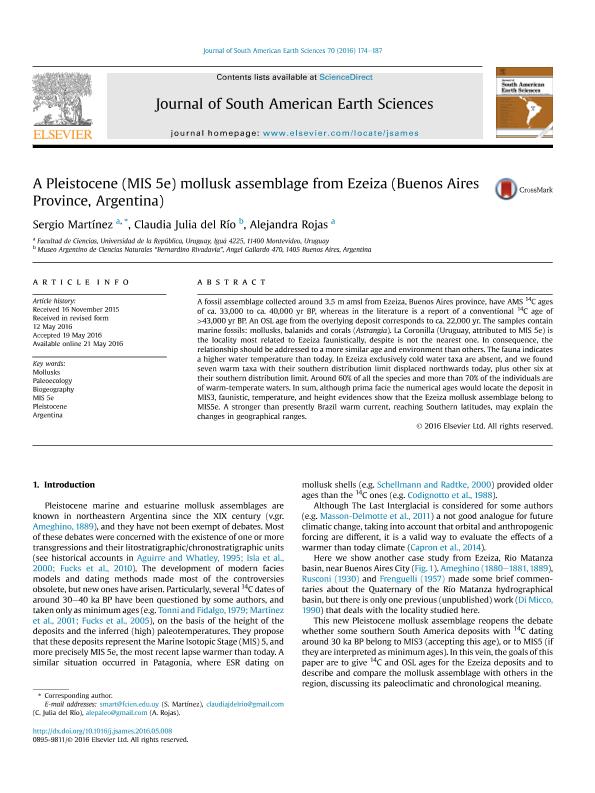Artículo
A Pleistocene (MIS 5e) mollusk assemblage from Ezeiza (Buenos Aires Province, Argentina)
Fecha de publicación:
10/2016
Editorial:
Pergamon-Elsevier Science Ltd
Revista:
Journal of South American Earth Sciences
ISSN:
0895-9811
Idioma:
Inglés
Tipo de recurso:
Artículo publicado
Clasificación temática:
Resumen
A fossil assemblage collected around 3.5 m amsl from Ezeiza, Buenos Aires province, have AMS 14C ages of ca. 33,000to ca. 40,000 yr BP, whereas in the literature is a report of a conventional 14C age of >43,000 yr BP. An OSL age fromthe overlying deposit corresponds to ca. 22,000 yr. The samples contain marine fossils: mollusks, balanids and corals(Astrangia). La Coronilla (Uruguay, attributed to MIS 5e) is the locality most related to Ezeiza faunistically, despite isnot the nearest one. In consequence, the relationship should be addressed to a more similar age and environment than others.The fauna indicates a higher water temperature than today. In Ezeiza exclusively cold water taxa are absent, and wefound seven warm taxa with their southern distribution limit displaced northwards today, plus other six at their southerndistribution limit. Around 60% of all the species and more than 70% of the individuals are of warm-temperate waters.In sum, although prima facie the numerical ages would locate the deposit in MIS3, faunistic, temperature, and heightevidences show that the Ezeiza mollusk assemblage belong to MIS5e. A stronger than presently Brazil warm current,reaching Southern latitudes, may explain the changes in geographical ranges.
Palabras clave:
Mollusks
,
Paleoecology
,
Biogeography
,
Mis 5e
,
Pleistocene
,
Argentina
Archivos asociados
Licencia
Identificadores
Colecciones
Articulos(MACNBR)
Articulos de MUSEO ARG.DE CS.NAT "BERNARDINO RIVADAVIA"
Articulos de MUSEO ARG.DE CS.NAT "BERNARDINO RIVADAVIA"
Citación
Martinez, Sergio; del Río, Claudia Julia; Rojas, Alejandra; A Pleistocene (MIS 5e) mollusk assemblage from Ezeiza (Buenos Aires Province, Argentina); Pergamon-Elsevier Science Ltd; Journal of South American Earth Sciences; 70; 10-2016; 174-187
Compartir
Altmétricas




